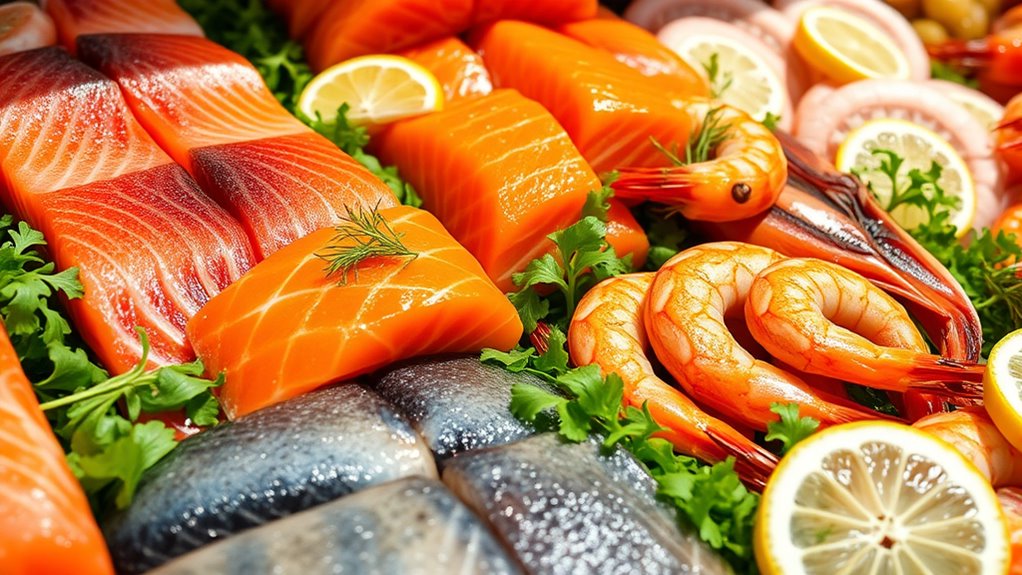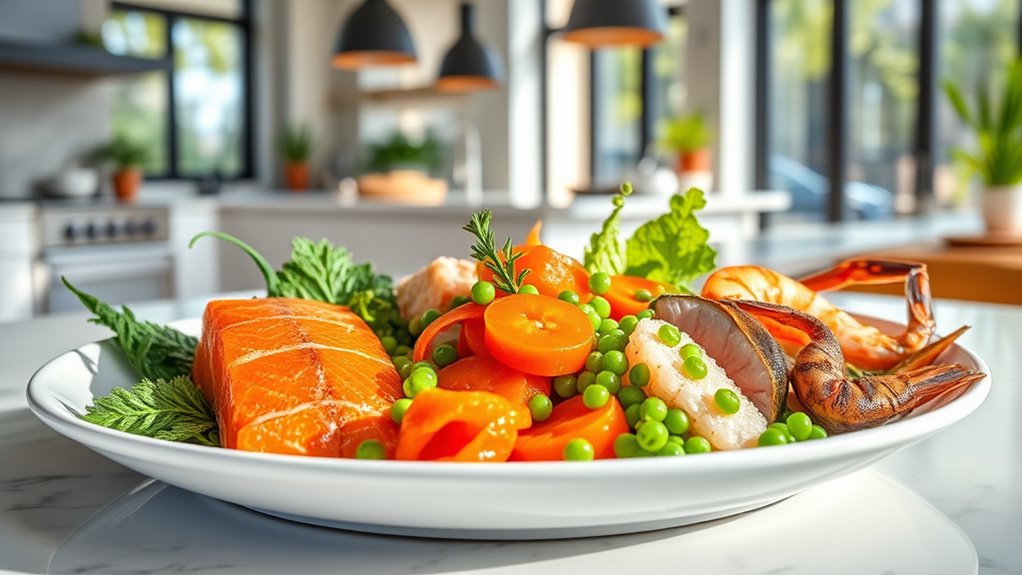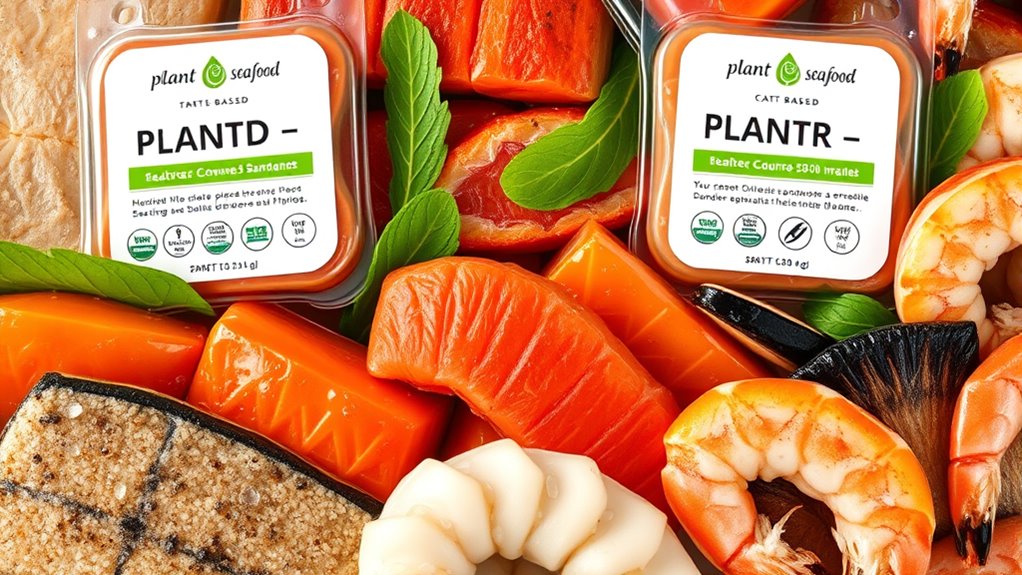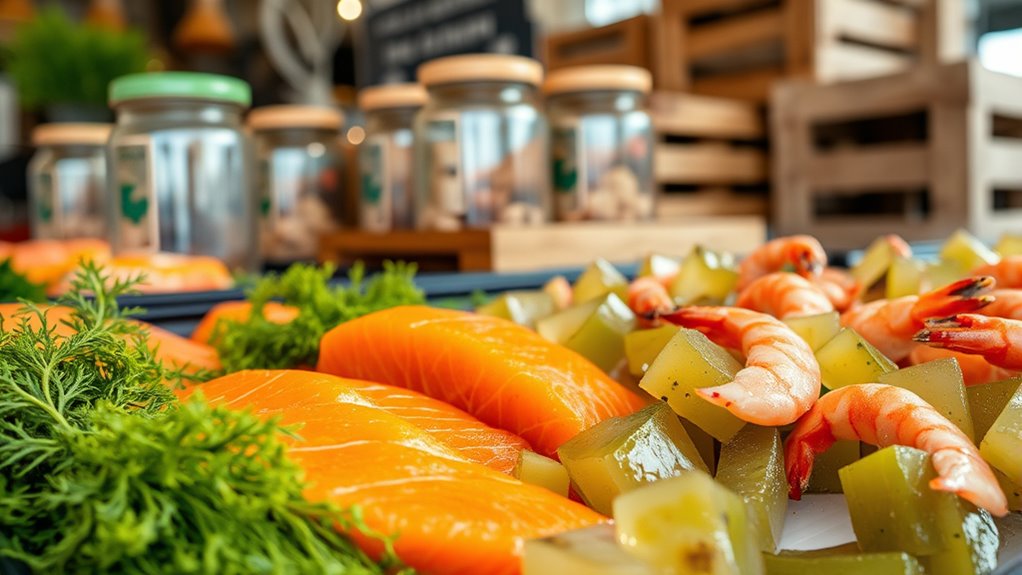Plant-based seafood alternatives are rapidly rising due to growing concerns over overfishing, environmental damage, and health. Innovative technologies and ingredients like pea proteins, algae oil, and advanced texturization make these products more appealing and sustainable. Leading brands are expanding their offerings, and regulatory efforts ensure transparency and safety. If you want to discover how these shifts are shaping our food future, keep exploring the latest breakthroughs and market developments.
Key Takeaways
- Growing consumer demand for sustainable and health-conscious seafood options is driving the market expansion of plant-based alternatives.
- Technological innovations like advanced texturization and flavoring improve the realism and appeal of plant-based seafood products.
- Environmental concerns about overfishing and habitat destruction are motivating industry shifts toward sustainable plant-based solutions.
- Regulatory frameworks and transparent labeling support consumer trust and facilitate industry growth in plant-based seafood.
- Major brands and startups are increasing product variety, partnering with retailers, and investing in marketing to normalize plant-based seafood.
The Environmental Impact of Traditional Seafood

Traditional seafood harvesting considerably impacts the environment, often leading to overfishing, habitat destruction, and high carbon emissions. When you fish unsustainably, fish populations decline faster than they can replenish, threatening ecosystems and the species that depend on them. Coastal habitats like coral reefs and seagrass beds suffer damage from trawling, destroying breeding grounds and reducing biodiversity. Additionally, fishing activities consume significant fossil fuels, releasing carbon emissions into the atmosphere. These practices not only harm marine life but also threaten food security for communities relying on seafood. Overharvesting depletes stocks, making it harder for future generations to access these resources. As you can see, traditional seafood harvesting poses serious ecological challenges that demand sustainable alternatives. Incorporating diversification strategies such as plant-based seafood options can help mitigate these impacts and promote healthier oceans.
Innovations in Plant-Based Seafood Development

Innovations in plant-based seafood development are transforming the way we approach sustainable eating. Cutting-edge research and technology enable producers to create products that closely mimic real seafood’s texture, flavor, and appearance. Here are three key innovations driving this shift:
Innovations in plant-based seafood are revolutionizing sustainable eating with realistic textures and flavors.
- Advanced Texturization Techniques: Using ingredients like konjac and pea proteins, manufacturers replicate the chewy, flaky texture of fish and shellfish.
- Flavor Enhancement Methods: Natural extracts and fermentation processes intensify seafood flavors, making plant-based options more authentic.
- Innovative Binding Agents: New plant-based binders improve product cohesion, ensuring seafood alternatives hold together during cooking and consumption.
- Additionally, applying Kia Tuning principles such as suspension upgrades and performance enhancements can inspire innovative ways to refine the texture and structural integrity of plant-based seafood products.
These innovations make plant-based seafood more appealing, sustainable, and accessible, encouraging more people to adopt environmentally friendly choices.
Key Ingredients and Technologies Behind Plant-Based Alternatives

Behind the success of plant-based seafood alternatives are key ingredients and advanced technologies that replicate the sensory qualities of real seafood. You’ll find ingredients like plant proteins, such as soy, pea, or wheat, that provide structure and texture. Natural flavors mimic the ocean’s briny taste, while fats like algae oil add juiciness and mouthfeel. Technologies like extrusion create fibrous textures resembling fish or seafood. Flavor enhancement techniques deliver savory, umami notes, and binding agents ensure stability. To visualize this, see the table below:
| Key Ingredient | Function |
|---|---|
| Plant Proteins | Structure and texture |
| Natural Flavors | Oceanic taste |
| Algae Oil | Juiciness and mouthfeel |
| Binding Agents | Stability and cohesion |
Innovative processing methods further enhance the realism and appeal of plant-based seafood options.
Leading Brands and Startups in the Market

You’ll want to explore the innovative product lines that set leading brands and startups apart in the plant-based seafood market. Their market expansion strategies often include new product launches and partnerships to reach broader audiences. Understanding these approaches reveals how they’re shaping the future of sustainable seafood alternatives. Additionally, many companies are designing cozy environments that appeal to families and seniors, fostering comfort and wellness in their homes.
Innovative Product Lines
Leading brands and startups are transforming the seafood industry by developing innovative plant-based products that mimic traditional fish and shellfish. These companies focus on creating realistic textures, flavors, and appearances to satisfy consumers’ seafood cravings without compromise. The use of unexplained phenomena in product development highlights the innovative approaches driving this sector forward. Here are three standout product lines: 1. Plant-based tuna that replicates the flaky texture and savory taste of canned tuna, perfect for salads and sandwiches. 2. Seafood-style shrimp made from pea protein, offering a crispy bite similar to real shrimp, ideal for stir-fries or cocktails. 3. Mimic fillets resembling salmon or whitefish, crafted from plant proteins and designed for grilling or baking. These innovations make plant-based seafood more appealing and accessible, encouraging more people to choose sustainable alternatives.
Market Expansion Strategies
As plant-based seafood brands seek to expand their market reach, they employ a variety of strategic approaches to capture consumer interest and increase sales. Many brands invest in targeted marketing campaigns that highlight sustainability and health benefits, appealing to eco-conscious consumers. Collaborations with restaurants and grocery chains help increase visibility and accessibility. Some startups focus on product innovation, offering unique flavors and textures to stand out. Expanding distribution channels, including online platforms, allows brands to reach broader audiences. Additionally, engaging in educational efforts about the environmental impacts of traditional seafood encourages consumer shifts. Leading brands often leverage social media influencers to boost brand awareness. Furthermore, understanding the importance of projector technology such as contrast ratio and color accuracy can inspire brands to develop more visually appealing packaging and promotional materials. Overall, these strategies help plant-based seafood brands carve out a larger share in the competitive alternative protein market.
Consumer Acceptance and Market Trends

Are consumers ready to embrace plant-based seafood alternatives? The market shows promising signs of growth, driven by increasing awareness of environmental and health benefits. Younger generations, in particular, are more open to trying new options, making them key drivers for acceptance. Here are three trends to watch:
- Growing demand for sustainable foods encourages more people to choose plant-based options.
- Improved taste and texture make these alternatives more appealing and comparable to traditional seafood.
- Rising availability in mainstream supermarkets boosts accessibility, normalizing plant-based seafood.
- Implementing mindful decluttering strategies can help consumers better evaluate their food choices and reduce unnecessary consumption.
While some still hesitate due to unfamiliarity or skepticism, overall acceptance is rising. As quality improves and awareness spreads, more consumers are likely to incorporate plant-based seafood into their diets.
Nutritional Benefits and Challenges

Plant-based seafood alternatives can offer important nutrients, but their composition varies widely between products. You should also watch out for potential allergens and added preservatives that might pose health concerns. Understanding these factors helps you make informed choices about incorporating them into your diet. Additionally, being aware of nutritional profiles can assist in selecting options that best meet your dietary needs.
Nutrient Composition Variability
While plant-based seafood alternatives offer an appealing option for sustainable eating, their nutrient composition can vary widely. This variability can impact your nutritional intake and overall health.
Here’s what you should watch for:
- Protein Content: Some products are rich in plant proteins, but others may have less, affecting muscle maintenance.
- Fat Levels: The types and amounts of fats differ, influencing heart health and calorie intake.
- Micronutrients: Vitamins and minerals like B12, iodine, and omega-3s may be inconsistent, requiring careful label reading or supplementation.
Understanding these differences helps you make informed choices, ensuring you get the nutrients you need without unexpected gaps or excesses.
Allergen and Additive Concerns
As you evaluate plant-based seafood alternatives, it’s important to contemplate potential allergen risks and the presence of additives. Some products contain common allergens like soy, nuts, or gluten, which could trigger reactions. Additives such as flavor enhancers, preservatives, and colorants are often included to improve taste and appearance but may cause sensitivities or health issues. To help you better understand, consider this overview:
| Allergen Risks | Additive Concerns |
|---|---|
| Soy, nuts, gluten | Preservatives, artificial colors |
| Cross-contamination possible | Flavor enhancers, stabilizers |
| Labeling inconsistencies | Long-term health effects |
Always read labels carefully, especially if you have allergies or sensitivities, to make informed choices. Understanding food labeling can further assist in identifying potential allergens and additives.
Regulatory Landscape and Labeling Standards

Have you ever wondered how regulatory agencies shape the standards for plant-based seafood alternatives? They play a crucial role in ensuring safety, transparency, and fair marketing. Here are three key aspects:
- Product Classification: Agencies determine whether plant-based seafood can be labeled as “fish” or “seafood,” affecting consumer expectations.
- Labeling Standards: Clear guidelines specify ingredient lists, allergen info, and nutritional data to prevent misleading claims.
- Approval Processes: New ingredients or production methods must undergo safety assessments before hitting the market, ensuring consumer protection.
- Additionally, agencies monitor market manipulation and promotional practices to maintain fair competition in the industry.
These regulations help build consumer trust and create a level playing field for producers. Staying compliant can be complex but essential for success in this growing industry.
The Future of Sustainable Seafood Consumption

Regulatory standards and transparent labeling have set the stage for a more sustainable future in seafood consumption. As consumers become more informed, you’ll likely prioritize options that are environmentally friendly and ethically sourced. The rise of plant-based seafood alternatives offers a promising solution to overfishing and habitat destruction. Expect more innovation in this space, with companies developing products that mimic the taste and texture of traditional seafood. Market demand will drive investments in sustainable practices, encouraging responsible fishing and aquaculture. Additionally, consumer awareness will push for clearer labeling, making it easier to choose options aligned with your values. Overall, a shift toward plant-based and sustainably sourced seafood will help reduce ecological impact while satisfying your desire for healthy, delicious alternatives.
How Plant-Based Seafood Is Shaping Global Food Policies

The rise of plant-based seafood alternatives is prompting governments worldwide to reevaluate and update their food policies. You’ll notice new regulations supporting plant-based products, ensuring they meet safety standards and labeling requirements. Governments are also incentivizing sustainable practices to reduce overfishing and promote eco-friendly farming. Finally, policies are increasingly emphasizing transparency, so consumers can make informed choices about plant-based options.
Governments are updating policies to support plant-based seafood, ensuring safety, transparency, and sustainability.
Here are three ways policies are evolving:
- Implementing clear labeling standards for plant-based seafood products.
- Offering subsidies or tax breaks for companies producing sustainable alternatives.
- Incorporating plant-based seafood into national dietary guidelines and sustainability goals.
Opportunities and Challenges for Industry Growth

As governments enhance policies supporting plant-based seafood, the industry faces a landscape ripe with opportunities for expansion. Increased regulatory support can lower barriers to market entry, encourage innovation, and boost consumer confidence. You can tap into growing awareness around sustainability and health benefits, which drive demand. However, challenges remain, including scaling production efficiently while maintaining quality and affordability. Consumer acceptance is essential, and you must address taste and texture preferences to compete with traditional seafood. Supply chain logistics and sourcing ingredients sustainably also pose hurdles. While the market potential is promising, success depends on overcoming these obstacles through innovation, strategic partnerships, and clear communication. By steering these opportunities and challenges, you can position your business for significant growth in this emerging sector.
Frequently Asked Questions
How Do Plant-Based Seafood Alternatives Compare in Taste to Traditional Seafood?
Your curiosity about how plant-based seafood compares in taste to traditional seafood is common. You might find that many alternatives mimic the flavor and texture quite well, especially with seasoned ingredients and innovative processing. However, some differences remain, like a slightly different mouthfeel or subtle flavor notes. Overall, you can enjoy these options for their sustainability and health benefits, and with some experimentation, they can become satisfying substitutes.
What Are the Environmental Benefits of Switching to Plant-Based Seafood?
Imagine you switch to plant-based seafood, and suddenly, you’re reducing ocean pollution and conserving marine life. By choosing these alternatives, you lower overfishing and decrease carbon emissions from fishing boats and seafood processing. For example, a community adopting plant-based options can markedly cut their environmental footprint. You help protect fragile ecosystems, promote sustainable practices, and support healthier oceans—all by simply making mindful seafood choices.
Are Plant-Based Seafood Options Suitable for People With Seafood Allergies?
If you have seafood allergies, plant-based seafood options might be suitable, but you should verify labels carefully. These alternatives typically use ingredients like seaweed, pea protein, or soy, which usually don’t trigger seafood allergies. However, manufacturing processes can sometimes introduce cross-contamination. Always read product labels and consult with your healthcare provider to ensure these options are safe for your specific allergy.
How Affordable Are Plant-Based Seafood Products Compared to Conventional Options?
Your curiosity about affordability is spot-on—plant-based seafood is changing the game! While some options might seem pricey, many are comparable to or even cheaper than traditional seafood, especially as production scales up. You can often find deals or store brands that make these alternatives more budget-friendly. Over time, as demand grows and technology advances, expect plant-based seafood to become even more affordable, making it an appealing choice for your wallet and the planet.
What Challenges Do Manufacturers Face in Scaling Plant-Based Seafood Production?
You face several challenges when scaling plant-based seafood production. You need to guarantee consistent quality and taste, which can be difficult with complex ingredients. Supply chain issues may cause shortages of key raw materials. You also must invest heavily in equipment and technology to meet growing demand. Additionally, steering regulatory approvals and educating consumers about plant-based options adds to the complexity, making expansion a demanding process.
Conclusion
As you explore plant-based seafood, imagine a future where sustainable choices become the norm, reducing ocean overfishing and environmental harm. While some skeptics believe seafood demand will always favor traditional options, innovations suggest you can enjoy delicious, eco-friendly alternatives without compromise. Embracing these innovations not only benefits the planet but also shapes a more responsible food industry—making sustainable seafood a reality you can actively support today.









